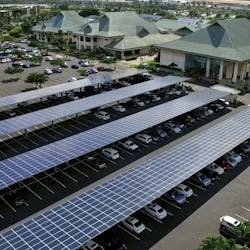University of Hawai'i Maui College campus achieves net-zero energy status
The University of Hawaiʻi Maui College says that its campus in Kahului has achieved net-zero energy status.
The university says in a news release that through a combination of solar photovoltaic energy, distributed energy storage and energy efficiency measures, Maui College has reduced the campus’ use of fossil fuel for energy by an estimated 100%.
More than 3,300 photovoltaic modules were installed, generating 1.58 megawatts of power, enough to power more than 200 homes annually and offsetting greenhouse gas emissions equal to 4,400 barrels of oil a year. The project also includes 13.93 megawatt hours of battery storage.
UH Maui College is among the first campuses in the nation to generate 100% of its energy from on-site solar photovoltaic systems coupled with battery storage. The project is part of a partnership with Johnson Controls and Mauō, a subsidiary of Pacific Current, and also includes four UH community college campuses on Oʻahu.
"We celebrate UH Maui College’s achievement and look forward to Kapiʻolani CC and Honolulu CC and Kauaʻi CC joining the UH Community College campuses that are making major gains towards UH’s goal of becoming net-zero by 2035,” says Erika Lacro, University of Hawai'i vice president for community colleges.
UH Maui College follows successful energy use reduction efforts at Leeward CC, which became the first net-zero UH campus in July 2020, and Windward CC, which reduced its carbon footprint by about 70% in September 2020. Honolulu CC, Kapiʻolani CC and Kauaʻi CC are also on track to reduce their carbon footprints.
Hawaiʻi has made a commitment to achieve 100% renewable energy by 2045. In 2015, UH and the Hawaiʻi Legislature established a collective goal for the university system to be “net-zero” by January 1, 2035, meaning the system would produce as much renewable energy as it consumes across its 10 campuses.
Video from the University of Hawai'i:
About the Author
Mike Kennedy
Senior Editor
Mike Kennedy, senior editor, has written for AS&U on a wide range of educational issues since 1999.
